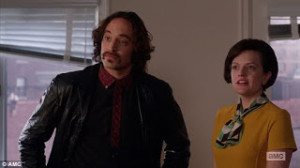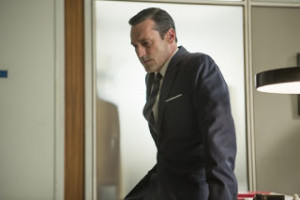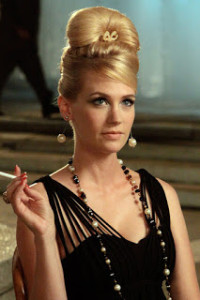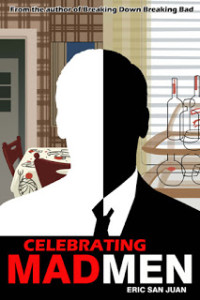The following is taken from Celebrating Mad Men, available in paperback and for Kindle.
MAD MEN AS A PERIOD PIECE
One of the great joys of Mad Men comes from being immersed in a time and place that is not our own. We delight not only in the look and feel of the show, but also in the way in which it’s instructive when it comes to how people lived and behaved just a few short decades ago. It not only allows us a glimpse into that world, it also puts our own modern world in context.
Because that’s what the best period pieces do, right? They capture a time and place so well and with such fidelity, the nature of our own world comes more clearly into focus.
However, Mad Men doesn’t fall into the same trap so many period pieces do: inserting modern day moralizing into the period.
That’s a good thing, because that can be a dangerous trap to fall into, pulling the audience out of the moment and making them feel as if they are being preached to.
On the show, we regularly see aspects of late 1950s/early 1960s American culture we’d find awful today. Even setting aside the big and obvious “isms,” we also have kids being locked in closets, careless littering, parents unconcerned when their kids draping themselves with plastic bags, kids romping around the car without seatbelts, drunk driving, adults slapping other parents’ children, and pregnant women drinking and smoking, just to name a few. Despite this often uncomfortable behavior, Mad Men passes no judgment. It does not ask us to look at this behavior through modern eyes. It does not present it to us and say, “Look at this! Wasn’t it awful?” It’s just something that exists in this particular world.
 And when it does confront issues that have since seen deep changes in our culture, such as matters of race, it still does so through the prism of yesteryear. There are few on the show we’d recognize as having truly modern viewpoints, and there are none who can be viewed as standing in for the audience’s point of view, as is typical with period pieces.
And when it does confront issues that have since seen deep changes in our culture, such as matters of race, it still does so through the prism of yesteryear. There are few on the show we’d recognize as having truly modern viewpoints, and there are none who can be viewed as standing in for the audience’s point of view, as is typical with period pieces.
For example, Peggy is younger and more forward thinking than her colleagues at work, though not more forward thinking than many of her peers outside the office. On a few occasions she pushes at the issue of race. Unlike her workmates, it’s an issue she is willing to confront with something more than the casual dismissiveness of, say, Roger Sterling. Still, she does not do so with all her heart. It’s not a crusade for her. She broaches the subject, awkwardly but sincerely, yet it’s an issue even she is only just beginning to feel comfortable with, and she’s the show’s first example of a “modern woman.”
Perhaps it’s because Peggy herself is at the center of her own equality movement. For example, at the height of the Civil Rights movement she expresses frustration at being left out of the boy’s club when it comes to business meetings and after work gatherings. While blacks hold rallies and the case for Civil Rights ends up on the tip of every tongue, she claims, “half of the things negroes can’t do I can’t do either, and no one seems to care.” She tells her boyfriend, Abe, that business is routinely done inside clubs she can’t get into because she’s a woman.
Tellingly, even the progressive Abe doesn’t take her seriously. “All right, Peggy,” he says with sarcasm, “We’ll have a civil right march for women.”
 Was Peggy wrong for equating her own struggles with those of blacks in America? Was she being selfish or was she correct? Does she have an equal cause to complain as those impacted by segregation?
Was Peggy wrong for equating her own struggles with those of blacks in America? Was she being selfish or was she correct? Does she have an equal cause to complain as those impacted by segregation?
The show offers no answers. Those are questions we must answer for ourselves as individuals.
This approach works so well because it ensures that characters like Peggy ring true. The sudden loudness with which the race debate took hold in America and the change in tone of that debate was something new even to a fairly progressive thinker like Peggy, who was herself struggling with her own obstacles. Meanwhile, someone like Abe might adopt the race issue as a cause, but can’t even consider the idea that gender equality was also a battle worth fighting.
The people who do talk deeply about matters of race, class, and gender are young people, fringe people, marginal people. They are the counterculture existing on the outskirts of Madison’s Avenue’s reality. We get fleeting glimpses into their world, but they’re not the mainstream, nor is their cause. We can see their views bubble up to the surface from time to time, and even exploding into the forefront on occasion, such as after the assassination of Martin Luther King Jr., but by and large these are people that Don and Peggy and Betty and others only occasionally (and awkwardly) mix with.
This refreshing choice is one of Mad Men’s great strengths. It would be easy for Mad Men to get political or to fill itself with social messages, to use itself as a platform for Important Social Commentary, but it doesn’t play that game. We don’t get a Very Special Episode. We don’t get poignant reminders of Issues We Should Care About. We just get an unvarnished, sometimes uncomfortable, and even more often uncomfortably casual window into another time and place.
It’s up to the viewer to take it from there.
 That said, it’s worth noting that while I’d argue that Mad Men presents its period without judgment and allows viewers to come to grips with what they’re seeing on their own, show creator Matthew Weiner suggests there is a larger purpose to that approach. Essentially, his casual approach to these issues is itself meant to be a message. He told the Chicago Tribune in 2007, “You tell me if this is a period piece: The men are asking, ‘Is this it?’ and the women are asking, ‘What’s wrong with me?’ You tell me if that sounds like it’s 1960 or 2007.”
That said, it’s worth noting that while I’d argue that Mad Men presents its period without judgment and allows viewers to come to grips with what they’re seeing on their own, show creator Matthew Weiner suggests there is a larger purpose to that approach. Essentially, his casual approach to these issues is itself meant to be a message. He told the Chicago Tribune in 2007, “You tell me if this is a period piece: The men are asking, ‘Is this it?’ and the women are asking, ‘What’s wrong with me?’ You tell me if that sounds like it’s 1960 or 2007.”
And indeed, when you peel things back and look more closely, it becomes clear that the period being depicted isn’t quite as distant as the fashion of the time may make it seem.
It’s still close enough to us, or we to it, that there’s a certain familiar pain beneath the viewing pleasure. Peggy would no longer have to be such an oddball, but her dilemmas and agonies would hardly be unfamiliar to an ambitious professional woman today. The sexual politics of the office might be submerged beneath a host of written and unwritten codes, but the dangerous temptation to mix work and play for pleasure and advancement has hardly died. Many marriages are still structured so that one spouse—more likely the woman—has to live out her ambitions through the other.
So clearly Weiner wants to say something with his show. That’s never really been in doubt, though. He’s too smart a creator and the show is too literary a piece of work for it to be nothing more than a period piece soap opera. The setting serves a purpose beyond window dressing. It’s supposed to tell us something about ourselves. In fact, in many ways it’s supposed to tell us more about ourselves than it is about the period.
The only way to really do that, though, is to present the period with full honesty. So in that sense, the show really does present its period without judgment, because in order for us to truly see the past for what it was, and in turn to see how little we’ve actually progressed, we’ve got to see the unvarnished truth without great big signs saying “important moral message here!”
That’s not to say the show is never ‘on the nose’ with this sort of commentary. Weiner clearly picks what is presented in order to make a statement. Rather, it’s to say that the messages imparted to us are woven into the fabric of the show in such a natural way they never feel like moralizing. If it’s true to the time and feels like a true reflection of the time and place central to Mad Men’s conceit, it’s on the table as far as story is concerned.
 Sal is an excellent example of the writers’ willingness to stay true to the social mores of the 1950s and early 1960s, even when it means losing a character we love and allowing our protagonists to be even bigger bastards than they usually are. Salvatore Romano (Bryan Bratt) was as pure and likable a character as has been on the show. Talented, honest, charming, he’s one of the few you’d leave alone with a $100 bill.
Sal is an excellent example of the writers’ willingness to stay true to the social mores of the 1950s and early 1960s, even when it means losing a character we love and allowing our protagonists to be even bigger bastards than they usually are. Salvatore Romano (Bryan Bratt) was as pure and likable a character as has been on the show. Talented, honest, charming, he’s one of the few you’d leave alone with a $100 bill.
But when a male client falsely accused Sal of making a pass at him, Sal had to go, and it was our “hero,” Don, who put him out of work.
Yet that was a fairly big moment. In many ways, it’s the little moments that truly put us into Mad Men’s world while also telling us a little more about our own.
When Betty’s children are hurt in a car accident, for instance, she’s concerned, but her concerns are superficial at best and indicative of where Betty comes from. In the accident, Sally gets a minor cut that may give her a scar. To Betty, this is awful. “A boy with a scar is nothing, but a girl?” It’s easy to laugh or cringe at Betty’s statement, but what does she know? All she knows is that her role in the world is to be pretty, catch herself a successful or handsome man, and be a darling little housewife. It’s a small line of dialogue, yet it speaks volumes.
The flippancy with which the characters deal with matters of race, religion and gender is enough to make many modern viewers cringe, but for the older characters these aren’t topics worth taking seriously. When Peggy and Roger are debating whether or not to hire Michael Ginsberg (Ben Feldman), for instance, Roger notes that Ginsberg is Jewish. For him, this is a positive – but not because he’s open-minded. “Everyone’s got one now. To tell you the truth, it makes the agency more modern,” he tells Peggy.
Weiner and company know we’re going to contrast this kind of frank dialogue with the kind of talk we’d tolerate today. As Heather Marcovitch and Nancy Batty write in the introduction to Mad Men, Women and Children: Essays on Gender and Generation, “part of Mad Men’s appeal is the pleasure contemporary viewers take in the apparent wrongheaded behavior and unenlightened attitudes of the characters. Pregnant mothers smoke, children, when they are not simply ignored, are physically disciplined by both parents and adult neighbors, a drunk-driving accident results in an overnight stay in a police station’s drunk tank and a fine.” It’s entertaining to watch this because it’s both alien to us and it’s instructive about our own modern world, but, they warn, there could be a danger of connecting that sort of behavior with the more glamorous aspects of the period (great clothing, classy dinners, etc.), effectively making the negative behavior seem more appealing. They fear such mixed messages can result in the negatives of the period becoming “in a sense inextricable from the same objects and behaviors that evoke admiration or nostalgia.”
 That stance is perhaps overstated – it’s hard to imagine many younger viewers would want to revert to that time, despite the surface appeal of the time’s look and feel – but in a way that’s exactly the sort of inner debate a show like this should inspire. Far from being a danger, this author argues that intertwining the appealing with the ugly presents the kind of moral and intellectual conflicts good storytelling should evoke. We should feel an inner conflict as we weigh the allure of well-dressed people having intelligent conversations over cocktails against the ugliness of empty marriages and casual bigotry. This is a good thing. It’s what makes the conversation about Mad Men so strong.
That stance is perhaps overstated – it’s hard to imagine many younger viewers would want to revert to that time, despite the surface appeal of the time’s look and feel – but in a way that’s exactly the sort of inner debate a show like this should inspire. Far from being a danger, this author argues that intertwining the appealing with the ugly presents the kind of moral and intellectual conflicts good storytelling should evoke. We should feel an inner conflict as we weigh the allure of well-dressed people having intelligent conversations over cocktails against the ugliness of empty marriages and casual bigotry. This is a good thing. It’s what makes the conversation about Mad Men so strong.
So yes, Mad Men is a period piece. It strives for authenticity not only in its technical details but in the behavior of the people who populate its world. And it’s a period piece that does not insert modern mores into the past, clumsily trying to deliver an Important Message to modern readers.
Instead, it presents us with a conflict. It gives us beautiful people living lives that are at times enviable, yet inside these are often ugly people living lives that are more pitiable than enviable. Sometimes we daydream of being there in the office with them, coming up with brilliant ideas over a glass of Scotch. Other times, we’re thankful at the societal changes we’ve experienced since the 1960s.
That inner conflict we feel is the point. It’s the reason why the honest approach to handling the era is more powerful than seeing the 1960s filtered through modern eyes.
Because there is no such thing as a black and white world.







